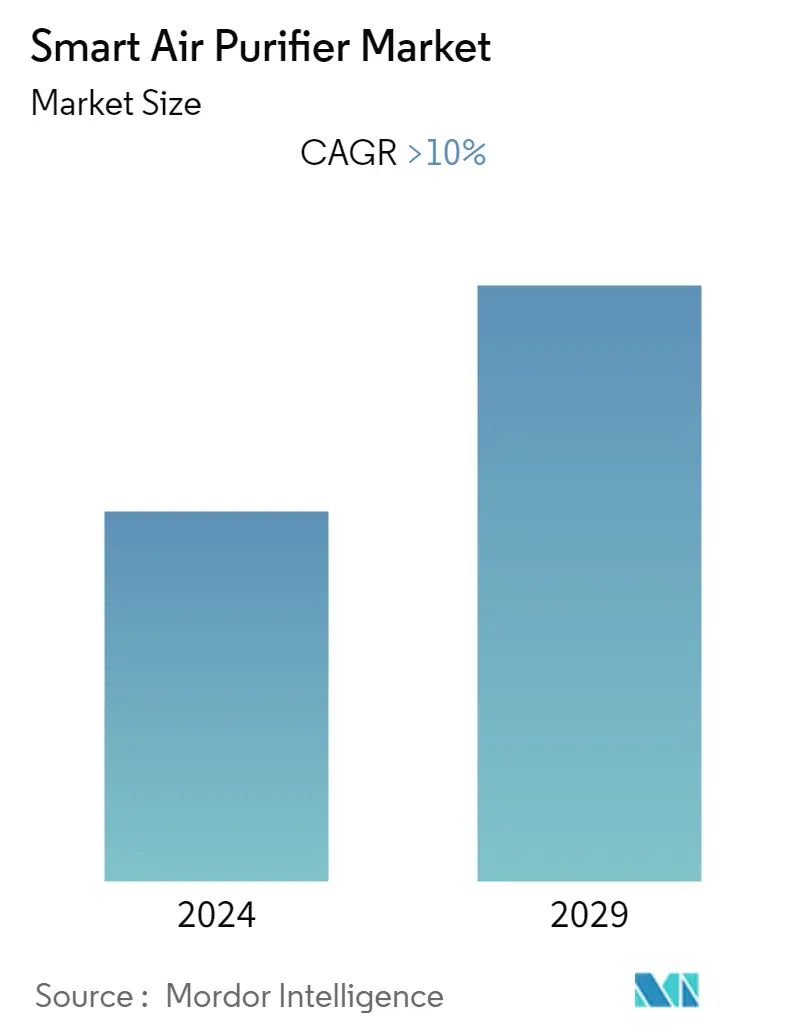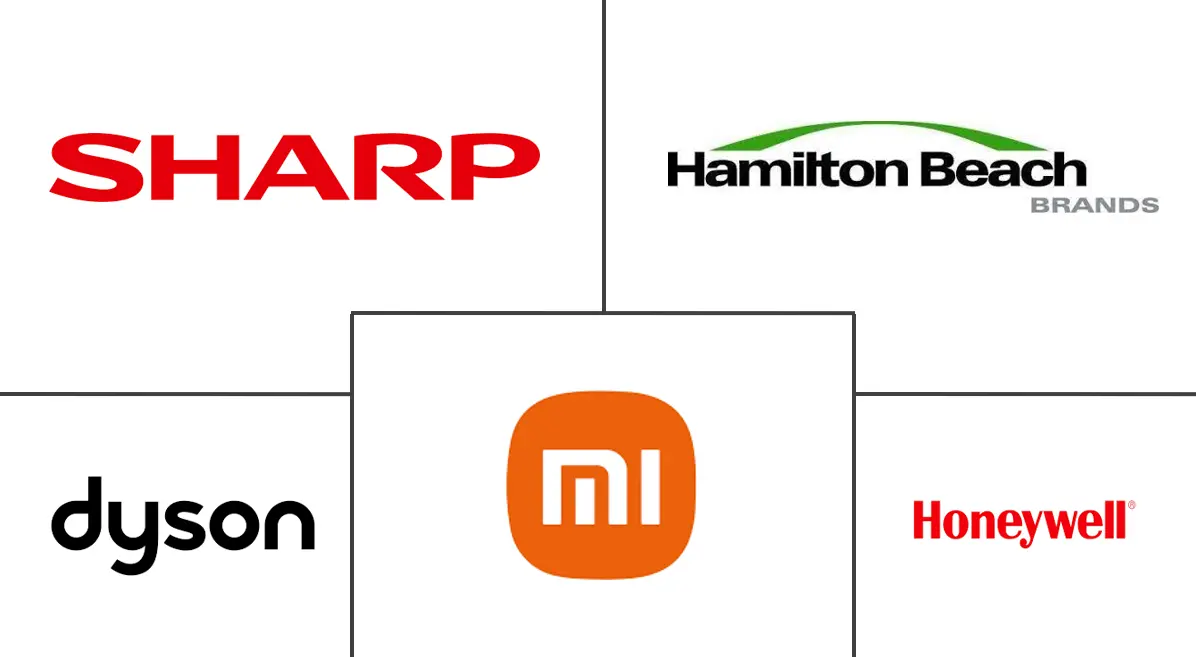Market Size of Smart Air Purifier Industry

| Study Period | 2020 - 2029 |
| Base Year For Estimation | 2023 |
| Forecast Data Period | 2024 - 2029 |
| CAGR | 10.00 % |
| Largest Market | Asia-Pacific |
| Market Concentration | Low |
Major Players
*Disclaimer: Major Players sorted in no particular order |
Smart Air Purifier Market Analysis
The Global Smart Air Purifier Market has generated a revenue of USD 2.92 billion in the current year and is poised to achieve a CAGR of 10% for the forecast period.
The smart air purifier is a modern version of a traditional air purifier that automatically filters the air for various end users. It can be controlled remotely by using an app on smartphones linked to smart air purifiers via wireless networks like Wi-Fi and Bluetooth. The main advantage of the smart air purifier is that customers can monitor and manage indoor air quality and adjust basic settings via smartphones. Additionally, these gadgets collect information on air quality from specialized monitoring sensors, automatically clean the air in accordance with that data, and alert users when air quality levels change.
Users can manage these purifiers by fine-tuning the air-cleaning settings using apps designed for smartphones. Smart air purifiers are mostly used and installed in indoor settings, including homes, small businesses and industrial buildings, and automobiles. Smart air purifiers come with technology that automatically removes smoke, dust, and fumes from the air. These gadgets come in versions that release air scented with safe chemicals that can enhance the ambiance and aroma of the environment.
Because of the COVID-19 pandemic, many companies in the smart air purifiers industry were forced to temporarily halt operations in order to comply with new government regulations aimed at preventing disease spread. This halt in operations had a direct impact on the revenue flow of the air filter market. Furthermore, due to a lack of raw materials and workers during the lockdown, industrial product production has ceased. Furthermore, no new consignments were received by businesses in this industry. As a result, the suspension of industrial activities and subsequent lockdown for several months had an impact on smart air purifier market share, and the market is expected to recover slowly during the projection period.
Urban areas have become much more polluted as a result of fast urbanization and increased construction activities. The need for smart air purifiers is being driven by the requirement for clean, odorless, dust- and smoke-free air in the environment. People are now more technologically oriented, and considerable investments in high-end technological items are anticipated to be positive signs for the expansion of the global economy. Due to rising per capita income and spending on medical equipment, it is projected that sales of these air purifiers would continue to climb in the near future.
High maintenance costs, frequent filter replacement, and premium installation fees have made air purifiers an overpriced expensive gadget, impeding market growth in the forecasted period.
Smart Air Purifier Industry Segmentation
A smart air purifier is an advanced version of a standard air purifier that is used for automatic air purification across multiple end users. It is linked to wireless networks such as Bluetooth and Wi-Fi and can be controlled remotely via a smartphone app. The global smart air purifier market report focuses on the market dynamics, trends, and demand for smart air purifiers in the market. The report offers an in-depth analysis of the key trends, segments, opportunities, and factors that are driving the market. Additionally, the key profiles of the major players in the global market are provided in detail.
Global Smart Air Purifier Market is Segmented by Type (Dust Collectors, Fume & Smoke Collectors, and Others), Technology (HEPA, Activated Carbon Filtration, and Others), Application (Residential, Commercial, and Others), Distribution Channel (Supermarkets/Hypermarkets, Specialty Stores, Online, and Other Distribution Channels), and Geography (North America, Europe, Asia-Pacific, South America, and Middle-East and Africa). The market sizes and forecasts are provided in terms of value (USD billion) for all the above segments.
| By Type | |
| Dust Collectors | |
| Fume & Smoke Collectors | |
| Others |
| By Technology | |
| HEPA | |
| Activated Carbon Filtration | |
| Others |
| By Application | |
| Residential | |
| Commercial | |
| Others |
| Distribution Channel | |
| Supermarkets/Hypermarkets | |
| Specialty Stores | |
| Online | |
| Other Distribution Channels |
| By Geography | |
| North America | |
| Europe | |
| Asia-Pacific | |
| South America | |
| Middle-East and Africa |
Smart Air Purifier Market Size Summary
The global smart air purifier market is experiencing significant growth, driven by the increasing demand for clean and healthy indoor air. These modern devices, which can be controlled remotely via smartphone apps, offer the convenience of monitoring and managing air quality in real-time. The market is expanding due to urbanization, rising pollution levels, and a growing awareness of the importance of air quality, particularly in densely populated regions like Asia-Pacific. The COVID-19 pandemic temporarily disrupted the market, but it is expected to recover as demand for anti-pollution products continues to rise. Despite challenges such as high maintenance costs and the need for frequent filter replacements, the market is poised for growth, supported by technological advancements and increasing consumer spending on health and wellness.
The Asia-Pacific region holds the largest market share, with countries like China and India leading due to their high pollution levels and rapid industrialization. North America and Europe are also witnessing growth, driven by health consciousness and stringent air quality regulations. The market is fragmented, with numerous global and regional players like Sharp Corporation, Dyson Limited, and Honeywell International, Inc. actively competing and investing in research and development to enhance product offerings. Recent product launches, such as Samsung's IoT-enabled air purifiers and Havells' Studio Meditate AP 400, highlight the industry's focus on innovation and meeting consumer demands for advanced air purification solutions. As the market continues to evolve, it is expected to benefit from increased health awareness and technological advancements in air purification.
Smart Air Purifier Market Size - Table of Contents
-
1. MARKET DYNAMICS AND INSIGHTS
-
1.1 Market Overview
-
1.2 Market Drivers
-
1.3 Market Restraints
-
1.4 Value Chain Analysis
-
1.5 Industry Attractiveness: Porter's Five Forces Analysis
-
1.5.1 Threat of New Entrants
-
1.5.2 Bargaining Power of Buyers
-
1.5.3 Bargaining Power of Suppliers
-
1.5.4 Threat of Substitutes
-
1.5.5 Intensity of Competitive Rivalry
-
-
1.6 Insights into Technological Advancements in the Industry
-
1.7 Insights on Various Regulatory Trends Shaping the Market
-
1.8 Impact of COVID-19 on the Market
-
-
2. MARKET SEGMENTATION
-
2.1 By Type
-
2.1.1 Dust Collectors
-
2.1.2 Fume & Smoke Collectors
-
2.1.3 Others
-
-
2.2 By Technology
-
2.2.1 HEPA
-
2.2.2 Activated Carbon Filtration
-
2.2.3 Others
-
-
2.3 By Application
-
2.3.1 Residential
-
2.3.2 Commercial
-
2.3.3 Others
-
-
2.4 Distribution Channel
-
2.4.1 Supermarkets/Hypermarkets
-
2.4.2 Specialty Stores
-
2.4.3 Online
-
2.4.4 Other Distribution Channels
-
-
2.5 By Geography
-
2.5.1 North America
-
2.5.2 Europe
-
2.5.3 Asia-Pacific
-
2.5.4 South America
-
2.5.5 Middle-East and Africa
-
-
Smart Air Purifier Market Size FAQs
What is the current Smart Air Purifier Market size?
The Smart Air Purifier Market is projected to register a CAGR of greater than 10% during the forecast period (2024-2029)
Who are the key players in Smart Air Purifier Market?
Sharp Corporation, Dyson Limited, Xiaomi Corporation, Honeywell International, Inc. and Hamilton Beach Brands, Inc are the major companies operating in the Smart Air Purifier Market.

